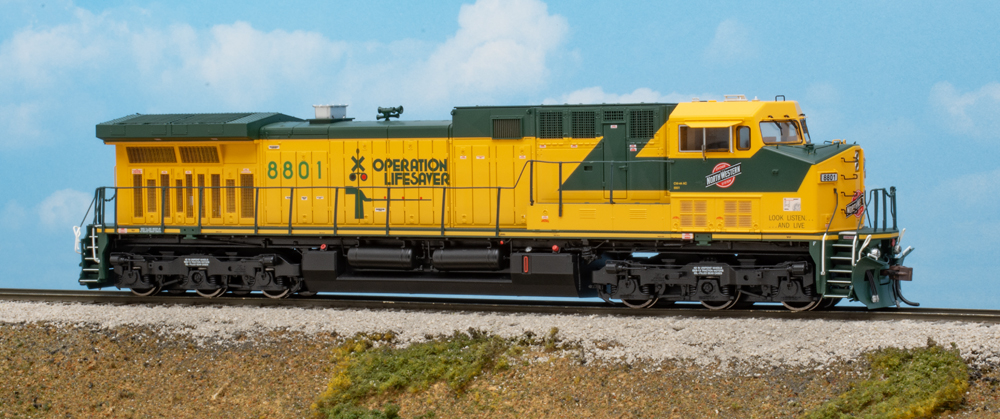
A General Electric AC4400CW diesel locomotive has joined the Athearn Genesis lineup. And no, this isn’t just an upgraded version of the “blue box” kit from the 1990s. The newly tooled six-axle road locomotive is offered with railroad-specific details, a full cab interior, and light-emitting-diode lighting, among other features.
The prototype
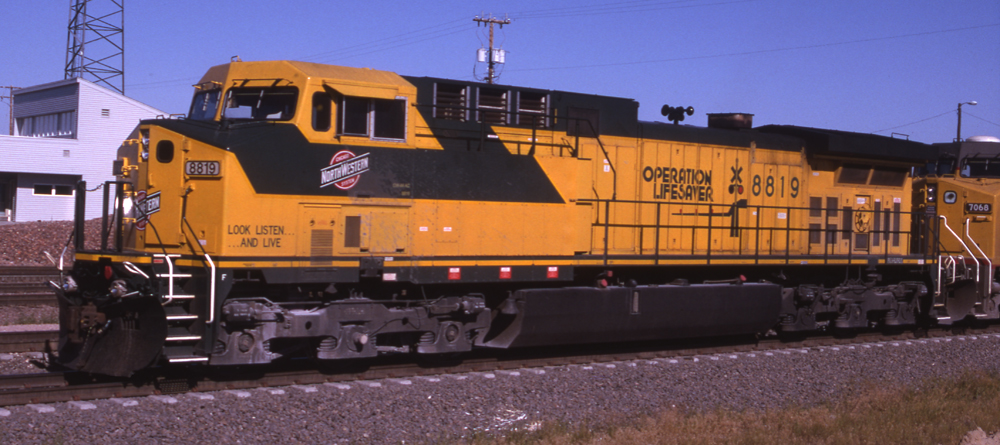
The sample we received is decorated as Chicago & North Western 8801, the class unit of the railroad’s 8801 through 8835 series built in November and December 1994. The full-size diesels were painted Traditional Yellow. Since the AC units lacked rear number boards, 4” yellow road numbers were applied to the back of the radiator wings. All of the units had the Operation Lifesaver logo on the long hood.
The C&NW ordered an additional 50 AC4400CWs, to be numbered 8836 through 8885, when the Union Pacific merger took place on April 25, 1995. Union Pacific proceeded with the order and received the units in October and November 1995. The locomotives were delivered in Armour Yellow and Harbor Mist Gray paint and were numbered in UP’s 6838 through 6885 series.
The 8801 was renumbered UP 6703 on November 7, 2003. The road locomotive operated in patched C&NW paint until late 2015-early 2016, when it was repainted in UP’s Building America scheme.
Model features
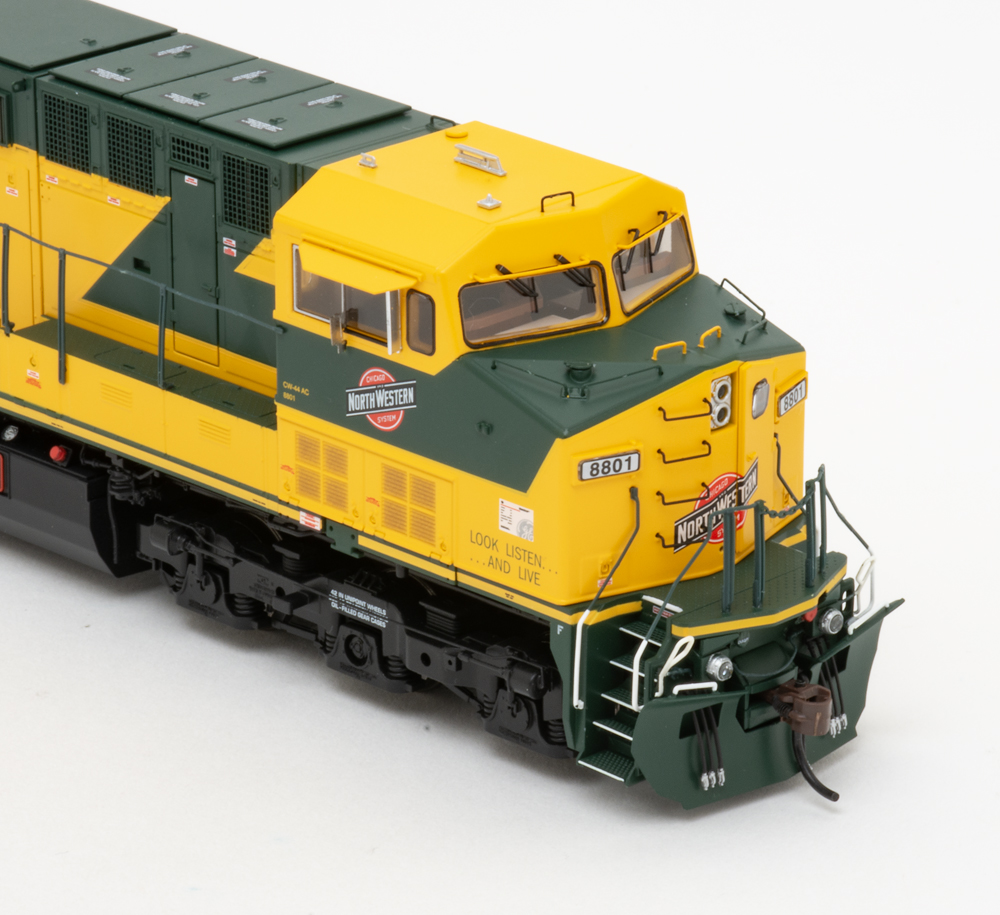
The Athearn HO General Electric AC4400CW features a multi-piece injection-molded plastic shell with a heavy die-cast metal chassis. The handrails and stanchions are Celcon, with a portion of the vertical railings in the stairwells painted white.
With 488 items in the parts list, this definitely is not a one-size-fits all model. There are more than 30 cab variations listed, more than 25 long hood options, and nearly 20 walkway versions shown in the exploded-view diagrams. Truck options include hi-adhesion with early inside and late outside strut configuration and GE steerable. All truck options feature sand line detail and rotating bearing caps.
The parts list also tips Athearn’s hand regarding future road names, as items for BNSF Ry.; Canadian Pacific; Ferromex; Ferrosur; Quebec, North Shore & Labrador; and Union Pacific are listed.
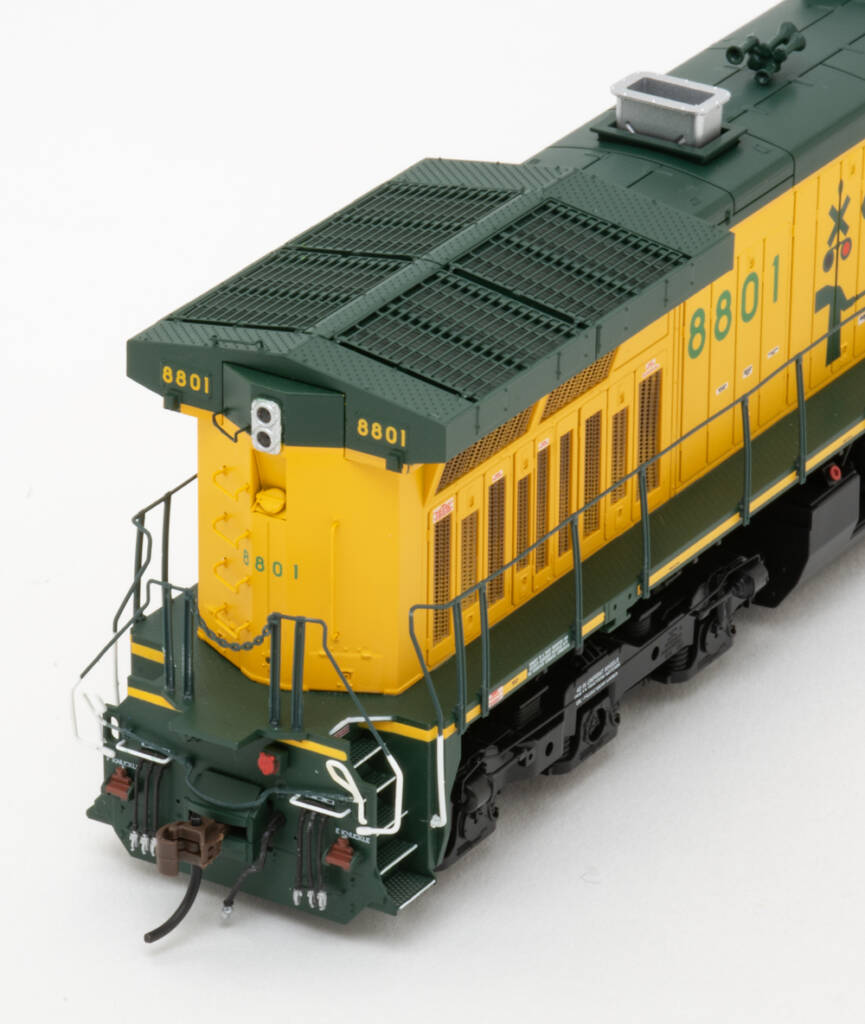
Features on our C&NW sample include a separate, factory-applied snow plow on the front pilot. Flexible rubber m.u. and trainline hoses, with the glad hands picked in silver, are woven through openings in the plow. The Celcon uncoupling lever is green with white handles. A pair of m.u. receptacles are tucked under the anticlimber. Ditch lights are mounted on the face of the front pilot.
The rear pilot has m.u. and trainline hoses, two wire grab irons, an uncoupling lever, and m.u. receptacles. In addition, there are spare Type E and F knuckles, both painted a rust color. The walkway steps are see-through, etched-metal parts. The walkways have raised nubs.
Cab features include wire grab irons; a nose door with flush-fitting window glazing; and factory-applied sand fillers, windshield wipers, and wind deflectors. A small mirror is located below the windows on the engineer’s side. Rooftop details include a round cab vent and three antennas painted silver.
The flush-fitting window glazing is clear on the front and back and slightly tinted on the sides. Inside, the AC4400CW has a detailed cab interior with three seats, a desk-style control stand, conductor’s console, and rear wall. Crew figures aren’t included, but there is plenty of room to add them.
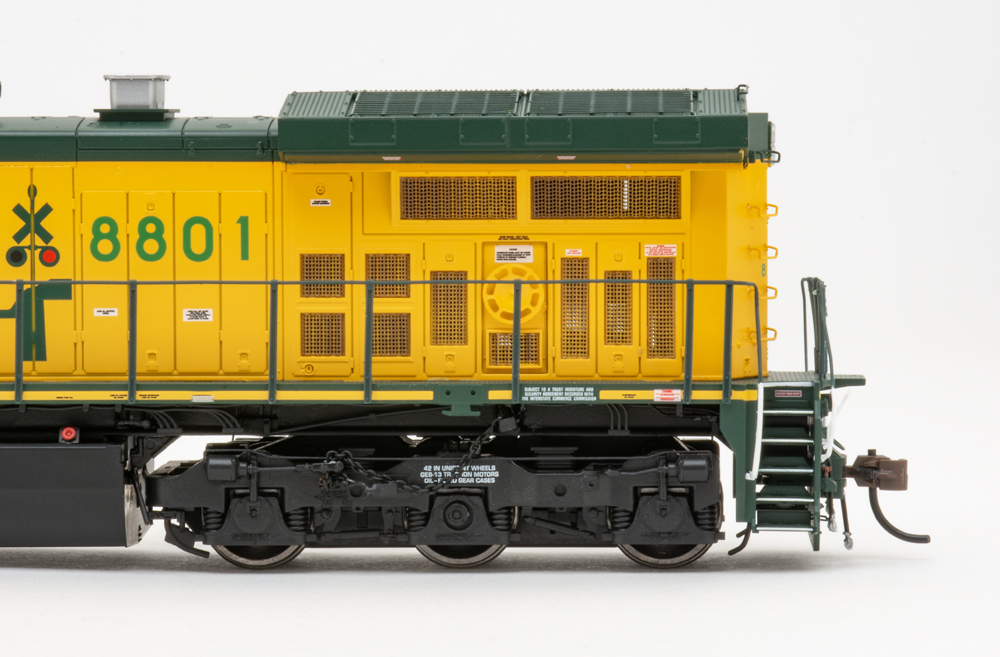
The body is based on an early prototype and has a mix of molded and freestanding details. The central air intake screens, lifting rings and hinges on the roof access doors, extended-range dynamic brake grids, and knuckle buster latches on the hood doors are molded. Factory-applied parts included a cast-brass Holden K5H air horn, a plastic exhaust stack with lip, and etched-metal radiator grills and lift tabs. The corrugated radiator and body side vents are see-through etched-metal parts with a light dusting of grimy black weathering. The brake wheel is a freestanding plastic part.
The rear of the long hood has a recessed sand fill hatch below the headlights, drop-style grab irons on the brakeman’s side, and a vertical grab on the engineer’s side. A single grab iron is attached to the top of the radiator.
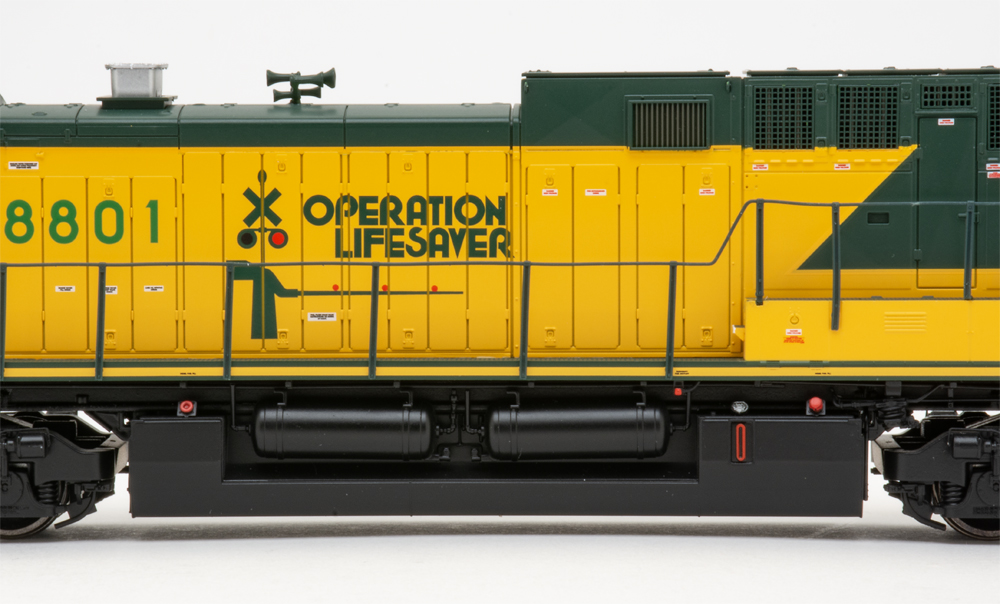
The C&NW AC4400CW is equipped with hi-adhesion trucks with struts mounted behind the brake cylinders. The middle axle on three of the four trucks is equipped with a rotating bearing cap. The middle axle on the front truck has a speed recorder on the brakeman’s side. A brake chain runs from the truck sideframe to a bracket glued to the side of the chassis on the rear brakeman’s side.
The North Western model has an early, straight fuel tank based on full-size versions that were bolted to the frame. The fuel tank has fillers, gauges, and breather pipes with details picked in red and silver as appropriate. A bell is mounted on the brakeman’s side front edge of the tank behind the truck. The engineer’s side of the fuel tank has two freestanding air tanks.
Under the shell
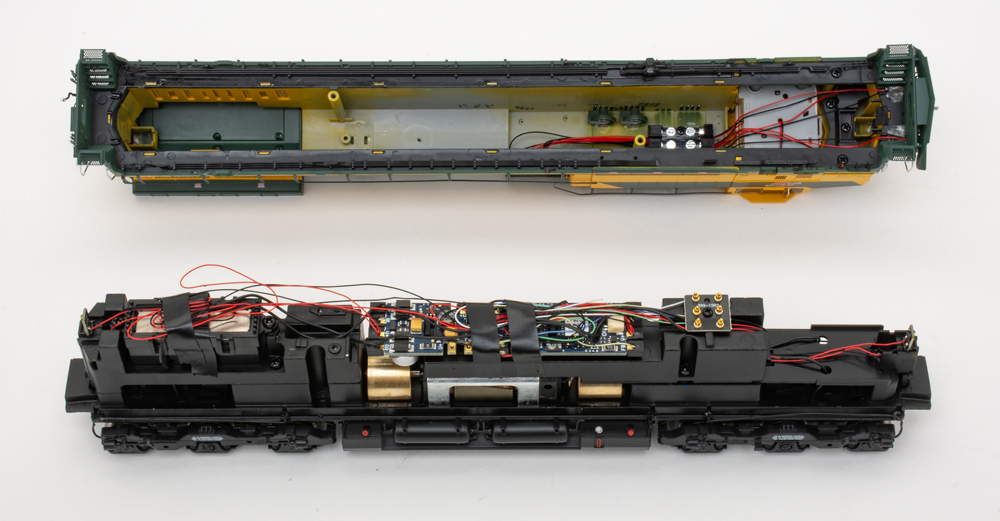
To separate the shell from the chassis, I first removed the front and rear draft-gear boxes. Then I took of the plastic fuel tank to reach two additional screws, one behind the front truck on the brakeman’s side and one in front of the rear truck on the engineer’s side. There are no tethered wires, so the shell slid off effortlessly.
The five-pole skew-wound motor, framed by two flywheels, is centered in the chassis. The front weight spans the motor. A plastic printed-circuit (PC) board mount is attached to the weight with a pair of screws. The PC board has two rectangular slots that fit around tabs on the mount. The SoundTraxx Tsunami2 decoder is attached to the PC board.
The rear weight is attached to the chassis with two screws. A pair of cube-style speakers fit inside a plastic housing on top of the weight. At the back of the weight is a PC board with a light-emitting-diode (LED) for the rear headlight. The front headlight, ditch lights, front and rear walkway lights, and ground lights above the front truck are also illuminated with LEDs.
Tale of the tape
Our sample is neatly painted C&NW Traditional Yellow and green with crisp separation lines between colors. The placement of the herald, warning labels, and other stickers matched prototype images that I found online. The stencils on the truck sideframes looked to be a touch oversize.
I compared our sample to prototype drawings published in The Car and Locomotive Cyclopedia of American Practice (Simmons-Boardman Books Inc., 1997). The model’s dimensions match or are within scale inches of published dimensions.
The model we received features a dual-mode SoundTraxx Tsunami2 sound decoder. I first tested the model in our workshop using an NCE Power Cab. The model moved at 4 smph at step 1. The road locomotive achieved a top speed of 71 smph at step 28. The full-size engines had a maximum speed of 75 mph.
I then took the C&NW unit over to our Milwaukee, Racine & Troy for testing in a layout environment. The model pulled a train of 89-foot auto racks without issue on the main line. The locomotive muscled 13 50-foot freight cars up the 3 percent grade between Bay Junction and Skyridge.
With more than 2,800 prototypes built between 1993 and 2004, the GE AC4400CW was a common prototype, and many examples can be found in service today. If you’re looking for some big road power for your HO scale layout, you’ll certainly want to take a look at this new model from Athearn.
Click here to see a video of the Athearn Genesis AC4400CW in operation on our Milwaukee, Racine & Troy staff layout.
Facts & features
Price: Direct-current model with 21-pin NEM connector, $264.99; with dual-mode SoundTraxx Tsunami2 sound decoder, $364.99. Add $10 to Primed for Grime models.
Manufacturer
Athearn Trains
2904 Research Rd.
Champaign, IL 61822
Era: November 1994 to November 7, 2003 (as decorated)
Road names: Chicago & North Western, The CIT Group, CSX, Kansas City Southern, Southern Pacific, and Union Pacific (“Primed for Grime” Southern Pacific patchout, two road numbers). Three numbers per scheme unless noted.
Features
- All-wheel drive and electrical pickup
- Body-mounted McHenry scale couplers, at correct height
- RP-25 contour metal wheel stubs on plastic axles, in gauge
- Weight: 1 pound, 5.5 ounces














Curious why you set the throttle at 1 – 28 steps instead of 1 – 128. The latter gives much better low speed control and should be an option on your throttle.
The proper nomenclature for the air hoses on each end are MU2-A hoses and Brake Pipe hose.